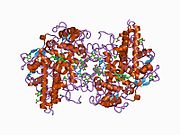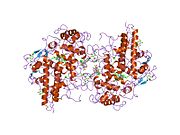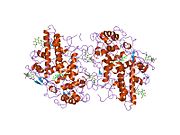Myeloperoxidase
Ensembl | |||||||||
|---|---|---|---|---|---|---|---|---|---|
| UniProt | |||||||||
| RefSeq (mRNA) | |||||||||
| RefSeq (protein) | |||||||||
| Location (UCSC) | Chr 17: 58.27 – 58.28 Mb | Chr 11: 87.68 – 87.7 Mb | |||||||
| PubMed search | [3] | [4] | |||||||
| View/Edit Human | View/Edit Mouse |
| Myeloperoxidase | |||||||||
|---|---|---|---|---|---|---|---|---|---|
| Identifiers | |||||||||
ExPASy | NiceZyme view | ||||||||
| KEGG | KEGG entry | ||||||||
| MetaCyc | metabolic pathway | ||||||||
| PRIAM | profile | ||||||||
| PDB structures | RCSB PDB PDBe PDBsum | ||||||||
| |||||||||
Myeloperoxidase (MPO) is a
The green color contributed to its outdated name verdoperoxidase.Myeloperoxidase is found in many different organisms including mammals, birds, fish, reptiles, and amphibians.[citation needed] Myeloperoxidase deficiency is a well-documented disease among humans resulting in impaired immune function.[9]
Function
MPO is a member of the XPO subfamily of peroxidases and produces
However, this hypochlorous acid may also cause
Myeloperoxidase is the first and so far only human enzyme known to break down carbon nanotubes, allaying a concern among clinicians that using nanotubes for targeted delivery of medicines would lead to an unhealthy buildup of nanotubes in tissues.[15]
Structure
The 150-
Variation in glycosylation and the identity of the heavy chain lead to variations in molecular weight within the 135-200 kDa range.
One of the ligands is the
Reaction mechanism
The central heme group acts as the active site. The reaction starts when hydrogen peroxide donates an oxygen to the heme group, converting it to an activated form called "Compound I". This compound then oxidizes the chloride ions to form the hypochlorous acid and Compound II, which can be reduced back down to its original heme state.[how?] This cycle continues for as long as the immune system requires.[citation needed]
Clinical significance
Antibodies against MPO have been implicated in various types of vasculitis, most prominently three clinically and pathologically recognized forms: granulomatosis with polyangiitis (GPA), microscopic polyangiitis (MPA); and eosinophilic granulomatosis with polyangiitis (EGPA). Antibodies are also known as anti-neutrophil cytoplasmic antibodies (ANCAs), though ANCAs have also been detected in staining of the perinuclear region.[21]
Recent studies have reported an association between elevated myeloperoxidase levels and the severity of
Medical tests
An initial 2003 study suggested that MPO could serve as a sensitive predictor for myocardial infarction in patients presenting with chest pain.[26] Since then, there have been over 100 published studies documenting the utility of MPO testing. The 2010 Heslop et al. study reported that measuring both MPO and CRP (C-reactive protein; a general and cardiac-related marker of inflammation) provided added benefit for risk prediction than just measuring CRP alone.[23]
Inhibitors of MPO
Azide has been used traditionally as an MPO inhibitor, but 4-aminobenzoic acid hydrazide (4-ABH) is a more specific inhibitor of MPO.[29]
See also
- Chloroma
References
- ^ a b c GRCh38: Ensembl release 89: ENSG00000005381 – Ensembl, May 2017
- ^ a b c GRCm38: Ensembl release 89: ENSMUSG00000009350 – Ensembl, May 2017
- ^ "Human PubMed Reference:". National Center for Biotechnology Information, U.S. National Library of Medicine.
- ^ "Mouse PubMed Reference:". National Center for Biotechnology Information, U.S. National Library of Medicine.
- ^ a b "Entrez Gene: Myeloperoxidase".
- S2CID 12489688.
- PMID 6192815.
- ISBN 9781260467529.
- ^ S2CID 36776058.
- ^ a b c d "Mouse MPO EasyTestTM ELISA Kit" (PDF). Archived from the original (PDF) on 2016-03-03. Retrieved 2015-08-06.
- PMID 8390491.
- PMID 9787133.
- S2CID 221865058.
- PMID 20043647.
- PMID 20364135.
- Clay Dillow (April 6, 2010). "Scientists Devise A Means For Human Bodies To Break Down Carbon Nanotubes". Popular Science.
- ^ PMID 8718890.
- PMID 9553712.
- ^ PMID 21297906.
- S2CID 222145838.
- PMID 11237766.
- S2CID 20296651.
- PMID 11694155.
- ^ PMID 20223364.
- PMID 15790935.
- PMID 16476484.
- S2CID 22084078.
- ISBN 1-84110-100-1.
- S2CID 25292707.
- PMID 9020887.








